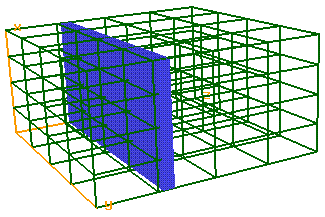
THE REAL WORLD IS 3D!
Most hydrodynamic simulations in this (and most other astronomy)
topics has been done in two dimensions assuming axisymmetry. There
are two good reasons for this:
- AXISYMMETRY IS A GOOD APPROXIMATION
- 3D SIMULATIONS ARE COSTLY
A typical simulation shown in this talk requires about 300 zones
per dimension and 2000 timesteps to reach a self-similar shape. On
a Cray T90 our code can compute 150,000 zones per second, requiring
100 hours for a 3D run.
On a parallel computer, using tens or even hundreds of processors,
this task becomes quite managable. On an IBM SP2 our MPI code can
compute 45,000 zones per second per processor. Running the same
3D job on 128 processors takes less than 3 hours of wall clock time!
 Our parallel version of VH-1 using MPI is extremely simple, but it
works very well and maintains the adaptability of VH-1 that has
made it so successful. Our approach is to break up
the 3D domain into 2D planes, with each plane computed on a
different processor. Evolution in the direction across planes
is computed locally
on individual processors after the data is transposed across
processors with a single MPI_ALLTOALL call.
Our parallel version of VH-1 using MPI is extremely simple, but it
works very well and maintains the adaptability of VH-1 that has
made it so successful. Our approach is to break up
the 3D domain into 2D planes, with each plane computed on a
different processor. Evolution in the direction across planes
is computed locally
on individual processors after the data is transposed across
processors with a single MPI_ALLTOALL call.
 Our parallel version of VH-1 using MPI is extremely simple, but it
works very well and maintains the adaptability of VH-1 that has
made it so successful. Our approach is to break up
the 3D domain into 2D planes, with each plane computed on a
different processor. Evolution in the direction across planes
is computed locally
on individual processors after the data is transposed across
processors with a single MPI_ALLTOALL call.
Our parallel version of VH-1 using MPI is extremely simple, but it
works very well and maintains the adaptability of VH-1 that has
made it so successful. Our approach is to break up
the 3D domain into 2D planes, with each plane computed on a
different processor. Evolution in the direction across planes
is computed locally
on individual processors after the data is transposed across
processors with a single MPI_ALLTOALL call.
